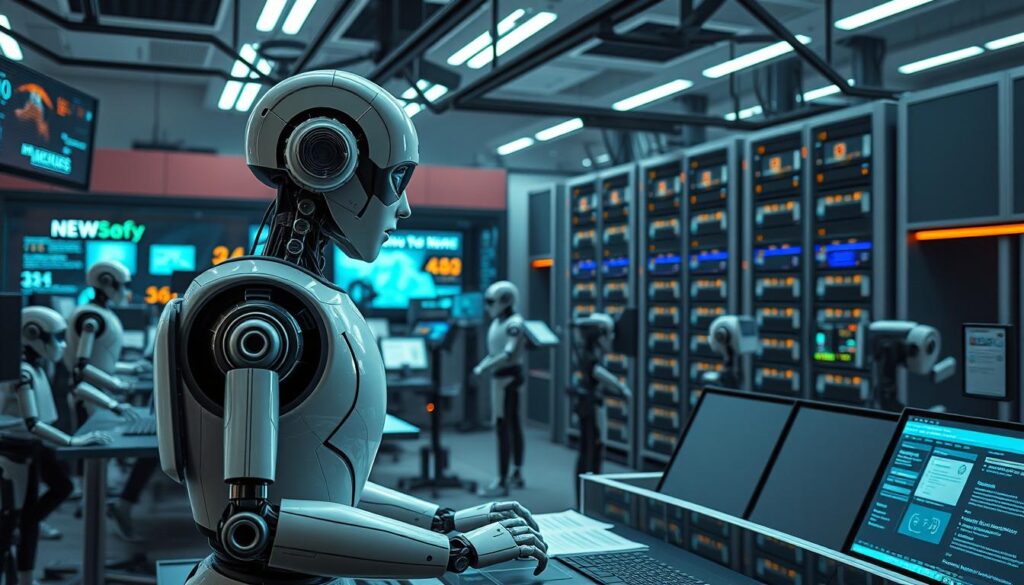As Albert Einstein once said, “It has become appallingly obvious that our technology has exceeded our humanity.” This sentiment rings true in the modern era, where advanced systems are reshaping how information is gathered and shared. These intelligent tools are now integral to content creation, offering unprecedented efficiency and accuracy.
Introduced in 2022, OpenAI’s ChatGPT marked a significant leap in capabilities, enabling tasks that were once unimaginable. These systems operate continuously, functioning as a 24/7 desk to monitor and curate relevant information. This transformation allows for rapid data processing and article creation, freeing up valuable time for deeper analysis and investigative work1.
Frameworks like CrewAI have further enhanced this process by enabling collaborative tasks among multiple systems. This teamwork improves efficiency and ensures high-quality output. For instance, larger models such as GPT-4o and Llama 3 70B have shown remarkable performance, delivering satisfactory results 9 out of 10 times1.
While these advancements are impressive, they also raise important questions about ethics and transparency. As these systems continue to evolve, their role in shaping the future of content creation remains a topic of both excitement and scrutiny.
Key Takeaways
- Advanced systems operate continuously, offering 24/7 monitoring and curation.
- Frameworks like CrewAI enhance collaboration and efficiency.
- Larger models deliver high-quality results consistently.
- These tools free up time for in-depth analysis and investigative work.
- Ethical considerations remain a critical focus in their integration.
Core Principle: AI Agents in Journalism: Automating News Reporting

The fusion of technology and traditional practices is reshaping how stories are told. Advanced systems are now at the heart of this transformation, offering unparalleled efficiency in gathering and sharing information2.
These tools bridge the gap between traditional journalistic methods and modern innovations. By combining large language models with autonomous agents, they streamline the process of turning raw data into engaging content2.
One of the key principles is task delegation. For instance, systems like CrewAI enable multiple agents to work collaboratively, ensuring timely and accurate article production2. This approach allows for real-time reporting, significantly reducing the time taken to create news stories.
These systems process vast amounts of information, identifying patterns and generating relevant content with minimal human intervention2. This not only enhances speed but also ensures consistency in quality.
However, the integration of such tools requires a robust technological framework. Platforms like GPT-4o and Llama 3 70B provide the backbone for these systems, delivering high-quality results consistently2.
“The future of storytelling lies in the seamless blend of human creativity and technological precision.”
As these systems continue to evolve, they are redefining the role of journalists. By handling routine tasks, they free up time for deeper analysis and investigative work, ensuring that the core values of journalism remain intact2.
The Evolution of News Reporting Technologies

The journey of news reporting has transformed dramatically over the decades. From traditional printing presses to digital platforms, the way information is shared has evolved significantly3. This shift has been driven by technological advancements, reshaping the media landscape.
In the early days, news was primarily distributed through newspapers and radio. These methods, while effective, were limited in speed and reach. The introduction of television marked a major milestone, bringing visual storytelling to the forefront3.
The rise of the internet revolutionized the industry. Digital media allowed for real-time updates and global reach. This shift paved the way for innovative models that prioritize efficiency and accuracy4. Today, automated systems handle tasks like transcription and content indexing, freeing up time for creative work.
Media organizations are leveraging these advancements to stay competitive. For example, tools like smart reframe automatically create social media-friendly content4. This evolution has not only improved speed but also enhanced accessibility and reach.
However, challenges remain. High implementation costs and technical requirements can be barriers to adoption4. Despite these hurdles, the benefits of modern systems are undeniable. They ensure timely delivery and consistent quality, setting a new standard for news reporting.
How AI is Transforming the Modern Newsroom

The modern newsroom is undergoing a digital revolution, reshaping how stories are crafted and shared. Advanced tools are now at the core of this transformation, enabling faster and more efficient workflows5.
These systems process vast amounts of data, turning raw information into compelling narratives. For example, natural language generation has increased productivity in story production by 30%6. This shift allows journalists to focus on in-depth analysis and investigative work.
Traditional newsroom operations are evolving into versatile, technology-driven organizations. Automated transcription and fact-checking are now common applications, saving time and reducing errors5. These tools ensure consistency and accuracy in reporting.
Task allocation is another key benefit. Intelligent systems assign roles among team members, creating a cohesive workflow. For instance, 70% of newsrooms use automatic triggers for publishing on social media platforms6. This approach enhances efficiency and ensures timely delivery.
Real-time data processing is revolutionizing news production. Tools like data analytics help organizations gauge audience response and tailor content accordingly6. This dynamic approach keeps readers engaged and informed.
“The future of storytelling lies in the seamless blend of human creativity and technological precision.”
Despite these advancements, challenges remain. Concerns about reliability and accuracy persist, with 75% of journalists expressing doubts about automated content6. However, with proper oversight, these tools can significantly reduce workload and improve efficiency.
For more insights on how technology is reshaping industries, visit this resource.
Fundamentals of Automated News Reporting

The integration of advanced systems into daily operations is redefining how information is processed and shared. These tools rely on cutting-edge technology to transform raw data into engaging narratives, streamlining workflows and enhancing efficiency7.
At the core of these systems are sophisticated platforms that support automated content creation. For instance, tools like CrewAI enable seamless collaboration, ensuring timely and accurate reporting7. This approach not only speeds up production but also maintains consistency in quality.
Automation significantly reduces the time spent on routine tasks, freeing up to 20% of journalists’ time for more creative and investigative work7. This shift allows teams to focus on in-depth analysis, ensuring that the core values of storytelling remain intact.
One of the key benefits is cost savings. By leveraging these systems, organizations can produce “commodity news” up to 12 times more efficiently than traditional methods7. This efficiency is further enhanced by continual advancements in technology, which refine the fundamental approaches to reporting.
“The future of content creation lies in the seamless blend of human creativity and technological precision.”
As these tools evolve, they are reshaping the platforms that support modern newsrooms. By automating tasks like transcription and fact-checking, they ensure accuracy and reliability, setting a new standard for the industry8.
Creating and Managing AI-Driven News Desks

Efficiency and structure are at the heart of modern newsrooms. By leveraging advanced systems, organizations can streamline workflows and enhance their service quality. These setups mimic traditional newsroom structures but with a focus on automation and collaboration9.
Defining Roles and Responsibilities
Clear roles are essential for smooth operations. In an AI-driven setup, each system is assigned specific tasks, such as data gathering, content creation, or fact-checking. This division ensures that every aspect of the workflow is covered efficiently9.
For example, one system might focus on real-time data monitoring, while another handles article formatting. This approach reduces overlap and maximizes productivity. By defining responsibilities, teams can achieve higher accuracy and consistency in their output10.
Coordinating Collaborative Tasks
Collaboration is key to success in these setups. Systems like CrewAI enable multiple agents to work together seamlessly. This teamwork ensures that tasks are completed on time and to a high standard9.
For instance, one agent might gather data, while another analyzes it and a third drafts the content. This division of labor mirrors traditional newsroom assignments but with greater speed and efficiency. Such coordination enhances the overall service quality in journalism10.
Managing these virtual teams requires strategic planning. Assigning roles like editors, journalists, and social media experts ensures a balanced workflow. This approach not only improves efficiency but also maintains the integrity of the content produced9.
Setting Up Automated News Reporting Systems

Selecting the right tools is critical for streamlining workflows in modern newsrooms. The right platforms can significantly enhance efficiency, accuracy, and scalability in content creation11.
Choosing the Right Tools and Platforms
When adopting automated systems, organizations must consider compatibility, cost, and ease of use. Platforms like CrewAI and LangChain are designed to handle complex tasks, making them ideal for newsrooms11.
Technological development has made automation more accessible to journalists. For example, tools like Zapier and Make simplify repetitive tasks, freeing up time for creative work12.
Efficiency is a key factor in tool selection. The Washington Post, for instance, uses automated systems to generate high school sports recaps, expanding coverage without increasing staff11. This approach demonstrates how the right tools can empower journalists to focus on impactful stories.
“The future of content creation lies in the seamless blend of human creativity and technological precision.”
Cost-effectiveness is another critical criterion. Automated systems can reduce production costs by up to 50%, making them a viable option for organizations of all sizes11. By leveraging these platforms, newsrooms can deliver breaking news almost instantaneously, a capability that was previously unimaginable11.
Finally, scalability ensures that systems can grow with organizational needs. Frameworks like CrewAI enable seamless collaboration, ensuring that tasks are completed efficiently and to a high standard11. This adaptability is essential for staying competitive in a rapidly evolving industry.
Working with CrewAI and Other AI Agent Frameworks

The rise of collaborative frameworks is reshaping how tasks are managed in dynamic environments. These systems streamline workflows, enabling teams to focus on strategic goals. One such framework, CrewAI, stands out for its ability to integrate multiple agents into a cohesive unit13.
Understanding CrewAI Components
CrewAI is built on a modular architecture, consisting of agents, tasks, and tools. Each agent is assigned a specific role, such as data gathering or content creation, ensuring a clear division of responsibilities14. This structure allows for seamless collaboration, even in complex environments.
Tools within CrewAI enhance agent capabilities, enabling them to perform actions like precision searches or data retrieval. For example, agents can analyze JSON files or GitHub repositories, streamlining the process of information gathering14.
Defining Agents, Tasks, and Tools
Agents in CrewAI are designed with distinct personas, outlining their roles and goals. This clarity ensures efficient task delegation and execution. Tasks are assigned based on agent capabilities, optimizing the workflow14.
Tools play a critical role in enhancing agent functionality. They allow agents to perform specific actions, such as monitoring social media trends or drafting emails. This integration reduces manual effort and improves accuracy15.
One common question is how these frameworks integrate with existing systems. CrewAI supports flexible integration with external APIs and databases, ensuring compatibility with various platforms15.
“The future of task management lies in the seamless collaboration of specialized agents.”
Practical examples illustrate the benefits of these frameworks. For instance, CrewAI has been used to automate content planning and stock analysis, significantly improving productivity14. These applications highlight the potential of such systems in modern workflows.
Leveraging Open Source Models for Enhanced Efficiency

Open source models are revolutionizing how organizations approach content creation, offering flexibility and cost-efficiency. These tools empower teams to customize solutions, ensuring they meet specific needs without the constraints of proprietary systems16.
One of the key advantages is cost-effectiveness. Open source models like Llama and other large language models (LLMs) reduce expenses significantly compared to closed-source alternatives. This allows organizations to allocate resources to other critical areas, such as research and development17.
Performance is another area where open source models excel. They deliver high-quality output, often matching or exceeding proprietary systems. For example, organizations using these tools have reported a 30% increase in efficiency when generating articles and other content16.
Customization is a major benefit. Open source models allow organizations to tailor solutions to their workflows. This adaptability ensures that the tools align with specific goals, enhancing both productivity and output quality18.
“The flexibility of open source models enables organizations to innovate and adapt in ways that proprietary systems cannot.”
Innovation thrives in open source environments. These models encourage collaboration and experimentation, leading to advancements in content creation. For instance, teams can modify algorithms to improve accuracy or integrate new features, driving continuous improvement17.
Examples of success are abundant. Organizations leveraging open source tools have streamlined workflows, producing high volumes of content with minimal errors. This approach not only saves time but also ensures consistency across posts and other materials16.
In conclusion, open source models offer a powerful alternative to proprietary systems. Their cost-effectiveness, performance, and customization capabilities make them invaluable for modern content creation. By embracing these tools, organizations can enhance efficiency and drive innovation in their workflows18.
Streamlining Fact-Checking and Data Verification

Accuracy and speed are critical in today’s fast-paced information landscape. Advanced tools are now playing a pivotal role in ensuring the reliability of content. These systems are transforming how organizations verify facts and process data, saving valuable time and resources19.
Automated verification tools are designed to scan large datasets for accuracy. They can quickly identify inconsistencies or unusual patterns, ensuring that only credible information is published. For example, tools like ClaimHunter have reduced the time to identify statements worth checking by 70 to 80 percent20.
These tools are particularly valuable in high-pressure environments. They allow journalists to focus on in-depth analysis while the systems handle routine verification tasks. This approach not only enhances efficiency but also improves the overall quality of reporting19.
Utilizing Automated Verification Tools
Major news organizations, such as Reuters and The Associated Press, have embraced these technologies. They use advanced systems to process vast amounts of information, ensuring that their content meets the highest standards of accuracy21.
One notable example is the use of Natural Language Processing (NLP) to customize news feeds based on reader preferences. This technology also helps identify fake news and spam by evaluating historical data, significantly improving fact-checking accuracy21.
These tools have also led to improvements in output reliability. By automating tasks like transcription and data analysis, organizations can produce content faster without compromising on quality19.
“The integration of advanced verification tools ensures that journalism remains a trusted source of information in the digital age.”
In the past year, 80% of newsrooms have implemented enhanced fact-checking protocols to combat misinformation19. This shift highlights the growing interest in leveraging technology to maintain credibility. As these tools continue to evolve, they will play an even greater role in shaping the future of reporting.
Enhancing Content Quality and Personalization

Personalized content delivery is reshaping how audiences interact with media. Advanced algorithms analyze user preferences to deliver tailored articles, increasing engagement and satisfaction22. This approach ensures that readers receive content that aligns with their interests, fostering sustained loyalty.
These algorithms play a critical role in transforming reader engagement. By monitoring social media trends and analyzing user behavior, they create targeted feeds that resonate with individual preferences22. This level of customization not only enhances the user experience but also improves job efficiency for content creators.
Personalized content can significantly improve job efficiency. Automated systems handle routine updates, freeing up time for journalists to focus on in-depth stories22. This shift allows teams to produce higher-quality work while maintaining a consistent output.
Data findings demonstrate the impact of these tools on content quality. Over one-third of consumers feel confident in their ability to craft relevant and engaging material22. This confidence reflects the growing reliance on technology to deliver accurate and timely information.
“The future of media lies in the seamless integration of technology and audience needs.”
Looking ahead, the future of personalized news delivery is promising. Emerging trends include hyper-personalization and real-time adaptability, ensuring that content remains relevant in a rapidly changing landscape23. These advancements will continue to shape the industry, offering new opportunities for innovation.
By leveraging these tools, organizations can enhance their source credibility and build stronger connections with their audience. This approach not only improves content quality but also ensures that the future of media remains dynamic and engaging.
Integrating AI Tools in Daily Journalistic Processes

Modern newsrooms are increasingly adopting advanced tools to streamline their daily operations. These systems are designed to handle routine tasks, ensuring a seamless output of articles and multimedia content24. By automating repetitive processes, journalists can focus on in-depth reporting, meeting the evolving need for quality storytelling.
One key benefit is the ability to produce consistent results. Automated systems analyze data, draft posts, and manage social media updates with precision25. This not only saves time but also enhances the overall quality of the content. For example, tools like NewsGPT have revolutionized how breaking news is delivered, ensuring accuracy and speed25.
Real-time implementation is another advantage. These tools monitor trends and process information instantly, allowing newsrooms to stay ahead of the curve24. This approach ensures that the output is timely and relevant, addressing the immediate need for up-to-date information.
Daily use cases highlight the practicality of these systems. From drafting financial reports to curating personalized content, advanced tools handle mundane tasks efficiently25. This frees up journalists to tackle complex stories, resulting in a more dynamic and engaging output.
“The integration of advanced tools ensures that newsrooms can deliver high-quality content while adapting to the demands of modern journalism.”
In conclusion, the integration of these systems has transformed daily workflows. By automating routine tasks, newsrooms achieve consistent results and meet the growing need for timely, accurate information. This evolution highlights the importance of leveraging technology to enhance journalistic practices24.
Overcoming Challenges and Ethical Concerns in AI Journalism

The integration of advanced systems into newsrooms has brought efficiency but also raised critical ethical questions. While these tools streamline workflows, they introduce challenges like bias and accuracy concerns. Addressing these issues is essential to maintain trust and credibility in modern storytelling26.
Addressing Bias and Accuracy Issues
One of the most pressing challenges is ensuring unbiased and accurate content. Studies show that systems can inadvertently perpetuate biases present in their training data27. For example, algorithm-generated stories are often perceived as more accurate but less pleasant to read compared to human-written content26.
To mitigate these risks, organizations must implement rigorous testing and monitoring. Tools like Reuters’ News Tracer have been effective in verifying breaking news, ensuring accuracy while reducing misinformation27. Continuous improvement and feedback loops are critical to refining these systems.
Maintaining Robust Editorial Oversight
Human oversight remains indispensable in balancing automation with ethical standards. Only 20% of newsrooms have established guidelines for using advanced tools, highlighting the need for stricter protocols28. Editorial teams must review and validate content to ensure it meets journalistic integrity.
Case studies like The Washington Post’s Heliograf demonstrate how automation can coexist with human judgment. By combining technology with editorial expertise, organizations can meet the growing demand for timely and trustworthy reporting27.
Ultimately, the key lies in fostering collaboration between systems and human editors. This approach ensures that the benefits of automation are harnessed without compromising ethical standards26.
“The future of storytelling depends on balancing technological efficiency with human integrity.”
By addressing these challenges head-on, newsrooms can build systems that not only meet reader expectations but also uphold the highest standards of accuracy and fairness. Continuous monitoring and adaptation will be essential to navigate the evolving landscape of modern reporting28.
Developing Technical Skills for AI-Driven Reporting

The evolving landscape of media demands new competencies from journalists. As news organizations increasingly adopt advanced tools, reporters must enhance their technical abilities to stay relevant. This shift is not just about keeping up with technology but also about leveraging it to improve storytelling and efficiency29.
Building AI Fluency
Understanding how advanced systems work is crucial for journalists. Fluency in these tools allows reporters to process large datasets quickly, uncovering hidden patterns and trends30. This skill is essential for producing data-driven stories that resonate with audiences.
Training programs and online resources can help journalists build this fluency. Platforms like Coursera and edX offer courses on data analysis and machine learning, making it easier to acquire these competencies31.
Mastering Automation and Coding Tools
Automation tools are transforming how newsrooms operate. Journalists who master these tools can automate repetitive tasks, freeing up time for more creative work29. For example, coding languages like Python and tools like Zapier are becoming indispensable in modern reporting.
Practical examples include using Python to scrape data from websites or automating social media updates. These skills not only improve efficiency but also open up new opportunities for investigative journalism30.
Continuous learning is key in this rapidly evolving field. Journalists must stay updated on the latest tools and techniques to remain competitive. For more insights on how technology is reshaping journalism, visit this resource.
“The future of journalism lies in the seamless integration of human creativity and technical expertise.”
By acquiring these technical skills, journalists can transform into multi-talented professionals, capable of handling both traditional and modern reporting challenges. This evolution ensures that the core values of journalism remain intact while embracing the benefits of technology31.
Future Trends in AI and Automated News Reporting
The future of content creation is being reshaped by innovative technologies that blend human creativity with advanced systems. These tools are not just enhancing workflows but also redefining how information is processed and shared32.
Emerging Multi-Model Strategies
One of the most exciting developments is the rise of multi-model strategies. By combining various systems, organizations can tackle specialized tasks with greater precision. For example, integrating tools for data analysis and content drafting ensures both speed and accuracy32.
These strategies also improve efficiency by automating repetitive tasks. This allows teams to focus on more complex and creative aspects of storytelling. The result is a more dynamic and engaging output that meets audience expectations33.
Collaborative Innovations in Newsrooms
Collaboration is another key trend shaping the future of content creation. Advanced systems enable seamless teamwork, ensuring that tasks are completed on time and to a high standard. For instance, tools like CrewAI allow multiple agents to work together, enhancing productivity32.
These innovations also open up opportunities for new roles within newsrooms. By integrating specialized agents, organizations can boost efficiency and maintain the integrity of their content. This approach ensures that the core values of storytelling remain intact while embracing technological advancements33.
“The future of content creation lies in the seamless integration of human creativity and technological precision.”
As these trends continue to evolve, they will reshape how information is reported and consumed. By leveraging multi-model strategies and collaborative innovations, organizations can stay ahead in a rapidly changing landscape32.
Strategic Implementation and Best Practices for AI in Media
Strategic implementation of advanced tools in media is reshaping workflows and enhancing efficiency. These systems are designed to complement human expertise, ensuring a seamless blend of technology and creativity34.
Integrating Advanced Tools with Human Expertise
Balancing automation with human insight is crucial for maintaining quality reporting. Approximately 50% of newsrooms consider themselves ready for this integration, while just over one-third have implemented an active strategy34. This approach ensures that the role of journalists remains central, with tools handling repetitive tasks.
For example, The Washington Post’s Heliograf system demonstrates how automation can coexist with human judgment. By combining technology with editorial expertise, organizations meet the growing demand for timely and trustworthy reporting35.
Measuring Success and Performance Metrics
Monitoring performance is essential to ensure the effectiveness of these tools. Key metrics include efficiency gains, accuracy rates, and audience engagement levels. Newsrooms using advanced systems report a 30% increase in productivity, allowing journalists to focus on in-depth stories34.
Le Parisien’s incremental approach to implementation, starting with community managers before expanding to wider groups, highlights the importance of continuous adaptation34. This ensures that systems remain effective and aligned with organizational goals.
“The future of media lies in the seamless integration of human creativity and technological precision.”
By adopting these best practices, media organizations can ensure that advanced tools enhance rather than replace the human role. This strategic integration fosters innovation while maintaining the core values of storytelling35.
Conclusion
The integration of advanced systems into storytelling has revolutionized how information is created and shared. These tools enhance efficiency, allowing for real-time updates and personalized content delivery36. For example, platforms like Google have developed tools that assist in verifying facts and identifying misleading information, ensuring credibility37.
While the benefits are clear, ethical considerations remain critical. Ensuring unbiased and accurate content is essential to maintain trust. Tools like Reuters’ News Tracer demonstrate how technology can coexist with human oversight, balancing speed with reliability37.
Looking ahead, the future of storytelling lies in the seamless blend of human creativity and technological precision. Continued exploration and learning will be key to harnessing these tools effectively, ensuring they enhance rather than replace the core values of journalism36.
FAQ
What is the core principle behind using AI in news reporting?
How has technology evolved in the field of news reporting?
What changes has AI brought to modern newsrooms?
What are the fundamentals of automated news reporting?
How can news organizations set up automated reporting systems?
What is CrewAI, and how does it help in news reporting?
How can open-source models improve efficiency in journalism?
What role does AI play in fact-checking and data verification?
How does AI enhance content quality and personalization?
What challenges do newsrooms face when integrating AI tools?
What skills are essential for journalists in an AI-driven environment?
What are the future trends in AI and automated reporting?
How can media organizations measure the success of AI integration?
Source Links
- Automating a Newsroom Crew with AI Agents and CrewAI
- AI in Journalism: The Role of Automated News Writing
- Digital Newsroom Transformation: A Systematic Review of the Impact of Artificial Intelligence on Journalistic Practices, News Narratives, and Ethical Challenges
- Industry Insights: The state of AI in broadcasting and production
- From transcription to trust: How AI is transforming news production – Editor and Publisher
- AI, Automation, and Newsrooms: Finding Fitting Tools for Your Organization
- 10 things about AI every newsroom should know
- INMA Knows AI and the Newsroom
- Artificial Intelligence in Journalism – Center for News, Technology & Innovation
- Artificial Intelligence in News Media: Current Perceptions and Future Outlook
- AI in Journalism: Transforming News Generation & Fact-Checking
- A Practical Newsroom Guide to Artificial Intelligence – ONA Resources Center
- Build agentic AI solutions with DeepSeek-R1, CrewAI, and Amazon SageMaker AI | Amazon Web Services
- What is crewAI? | IBM
- What is CrewAI? – GeeksforGeeks
- Open-source AI for News Generation | Restackio
- AI Agents in 2025: A Comprehensive Review and Future Outlook
- Artificial Intelligence | The Associated Press
- Automating Journalism with AI Technologies | Restackio
- Fact-Checkers Are Scrambling to Fight Disinformation With AI
- AI in News: Integrations, Case Studies, Possibilities
- How to Use AI for Personalized News Feeds?
- AI Agents for Content Generation: Enhancing Creativity, Efficiency, and Strategy
- AI IN NEWSROOMS: ASSESSING PERCEPTION, CHALLENGES AND POSSIBILITIES IN BANGLADESH’S MEDIA LANDSCAPE
- Top 6 AI Agents for Smart News Experiences
- AI in Journalism: Creating an Ethical Framework
- What we have learnt about Generative AI and journalism and how to use it
- AI Journalism Takes Center Stage: News Reporting Automated by Generative Models
- How Using Generative AI Will Impact Journalism
- AI-Powered Automated Journalism: Efficiency and the Fight Against Bias
- The future of journalism with AI-generated content
- AI, Robot Journalism and all Things Fungible – Innovation
- Key Considerations for Successful Integration
- AI in the media: moving from strategy to implementation
- AI is revolutionising journalism, and newsrooms must get on board
- The Future of Journalism: AI in News Content Creation







